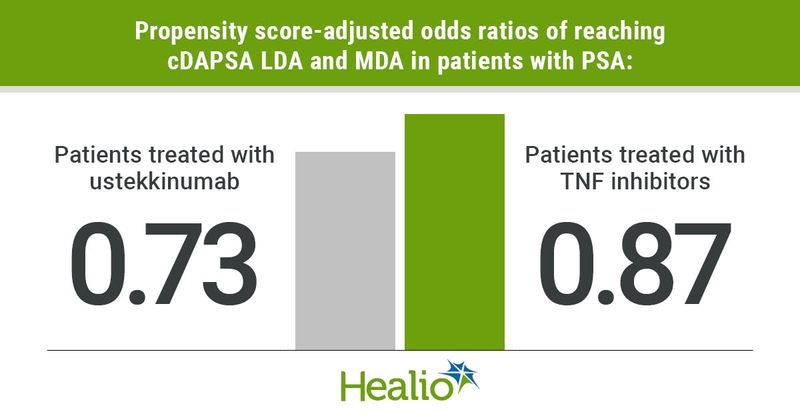Ustekinumab, TNF inhibitors exhibit similar remission, disease activity responses in PsA
Both ustekinumab and TNF inhibitors demonstrate significant improvement in psoriatic arthritis disease activity, with similar positive results in minimal and low disease activity, and remission, after 6 months, according to data.
“The interleukin (IL)-12 and IL-23/IL-17 axes are implicated as significant pathways in disease pathogenesis,” Josef S. Smolen, MD, of the Medical University of Vienna, and colleagues wrote in the Annals of the Rheumatic Diseases. “A number of [biologic disease-modifying antirheumatic drugs (bDMARDs)] directed against IL-12/IL-23, IL-17 or IL-23 are now available to treat PsA, alongside TNF inhibitors. The IL-12/23 axis can be inhibited with ustekinumab, a fully human immunoglobulin G1 monoclonal antibody that blocks the p40 subunit shared by these two cytokines.”

“Treatment decisions are challenging in PsA, given the wide array of available drugs, and the scarcity of head-to-head trials of biologics,” they added. “Although clinical trials provide important information on drug efficacy and safety, real-world patient populations may not fully represent those in clinical practice. There are currently no published studies in PsA comparing ustekinumab and TNFi effectiveness in a large-cohort, real-world setting. Such data are important for making evidence-based treatment decisions in clinical practice.”
To assess the effectiveness of ustekinumab (Stelara, Janssen), compared with TNF inhibitors, and analyze the predictors of low disease activity and remission, in patients with PsA, Smolen and colleagues conducted the PsABio study. According to the researchers, PsABio is an international, prospective, observational, cohort study of adults with PsA at 92 sites across eight European countries. Participants received either ustekinumab or a TNF inhibitor as a first-, second- or third-line treatment, and are followed biannually for up to 3-years. The first analysis was performed once all patients reached the 6-month milestone.

Among the initial roll of 991 recruited patients, 930 were deemed eligible and had baseline data. For this 6-month analysis, the researchers excluded an additional 62 participants with unavailable data, making for a final analysis set of 868 patients. Among these patients, 426 received ustekinumab, while the remaining 442 were treated with a TNF inhibitor. A total of 44 participants switched from, or stopped using, TNF inhibitors during the first 6 months, while 28 switched or ceased taking ustekinumab.
For this analysis, the researchers compared clinical Disease Activity Index for Psoriatic Arthritis (cDAPSA) low disease activity (LDA) and remission, as well as minimal disease activity (MDA) and very LDA, between the two treatment groups at 6 months. The analysis included propensity score-adjusted multivariate logistic regression.
According to the researchers, 45.7% of participants in the ustekinumab group achieved cDAPSA LDA at 6 months, compared with 50.7% of those who received a TNF inhibitor. cDAPSA remission was achieved in 14.9% and 19.2% of patients, respectively, while MDA was demonstrated in 26.4% and 30.8%, respectively. Ultimately, the propensity score-adjusted odds ratios of reaching cDAPSA LDA and MDA were 0.73 (95% CI, 0.46-1.15) for ustekinumab and 0.87 (95% CI, 0.61-1.25) for TNF inhibitors, suggesting no significant difference, the researchers wrote.
Meanwhile, high baseline BMI (OR = 0.94; 95% CI, 0.89-0.99) and high cDAPSA (OR = 0.64; 95% CI, 0.52-0.79) were associated with a lower chance of achieving cDAPSA LDA with TNF inhibitors. In addition, predictive factors were consistent with previously published data, with cDAPSA as well as 12-item Psoriatic Arthritis Impact of Disease scores and chronic widespread pain at baseline developing as new risk factors for poor outcome. Finally, safety data were similar between the treatment groups.
“After 6 months of treatment in a routine care setting, ustekinumab and TNFi, when used as a first-line, second-line or third-line bDMARD, demonstrated a significant DAPSA score improvement from baseline, with similar achievement of MDA, cDAPSA-LDA or cDAPSA remission in patients with PsA,” Smolen and colleagues wrote.
“This translated into a considerable enhancement of health-related quality of life, and a major reduction of disease impact on daily functioning, independently of ustekinumab or TNFi use,” they added. “Both baseline high disease activity and severe impact of the disease were modifiable negative predictive factors which might support early effective intervention in patients with PsA.”
